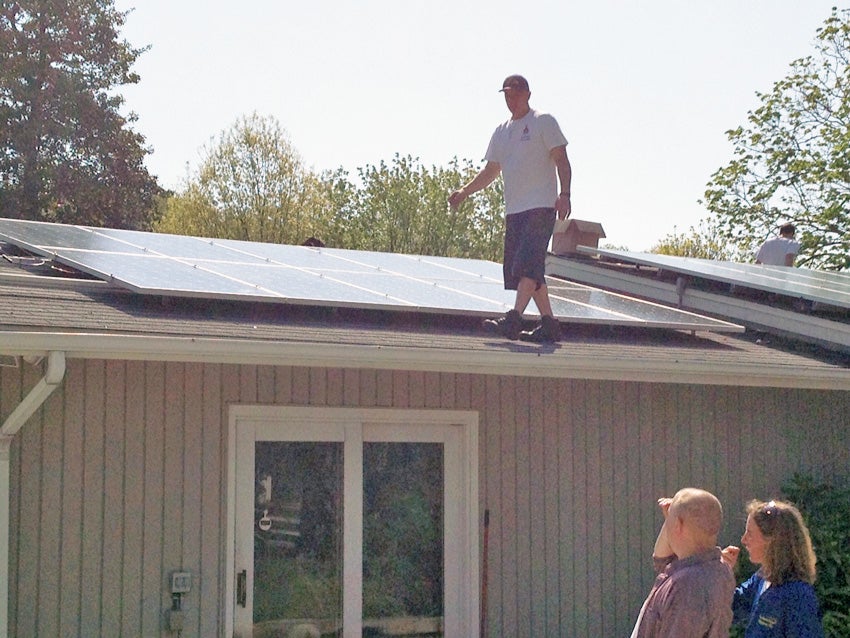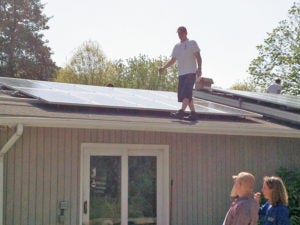Jill’s Solar Story: The Adventure of Going Solar

By Jill Siegel – Rockville, MD
I first looked into solar panels around 11 years ago. At the time I was having an in-ground pool built and looked into the possibility of using solar panels for heating the water. The cost was astronomical at that time … as I recall it was close to $70,000, which was more than the cost to construct the pool — and over ten times more than the cost of a propane heater and burying a large tank underground. I was hoping to not have additional dependency on a fossil fuel … but financially, I had to go with the propane.
In early 2011 I started looking into solar panels again … this time for the house. I had heard prices had come down quite a bit from 2002 and that there were incentives available that would help defray the cost. I met with a few companies during the first 18 months — but was not “wow’ed” by the companies, especially their inability to answer many of my questions.
In the summer of 2012, I was determined to move forward and complete this project! Every day the sun was out, I would kick myself that I had not yet “gone solar”. So I met with more companies, went to a “green” workshop, attended presentations by different solar companies in peoples’ homes, and did a lot of research and reading about PVs, inverters, and the entire process. I communicated with several people who had installed solar panels within the past 12 months and found out about their specific systems. I went to see a couple of residential installations.
In the end, I met with 9 different solar companies (3 of which are no longer in business). I compared leasing to buying. Leasing was not for me because in addition to wanting to reduce my carbon footprint, I wanted the greater savings and tax benefits you get from purchasing a system.
I selected Maryland Solar Solutions, Inc (MSSI) to handle my solar installation. I KNOW I chose the best company for my situation. I signed the contract and the design, permitting, installation and inspections were done in 37 days! My net meter from PEPCO was installed the following week. This was extraordinarily fast … not something that was anticipated but I sure am happy it was that fast!
What makes MSSI stand out from the rest is they are as interested in the success of your individual system as you are. It is a small, woman-owned Maryland company. The owner, Colette Hayward, was present from the initial meeting and throughout the installation where she was totally hands-on, working side-by-side with her employees installing the panels, wiring the boxes along with the electricians, checking the condition of the panels when they were delivered, and doing the walk-throughs during each county inspection. She was one of the first in this area to get her certification — only now are many companies getting someone certified because now it is required. Colette did it because she felt it was important … and did it long before it was required.

Of the nine different company representatives, Colette was one of only three contractors that went on my roof during our initial meeting. She took several readings to see what system would work best and estimated the output to provide an educated estimate regarding length of time until the system would pay for itself. She was the ONLY contractor who went into my attic space (not an actual attic but the kind you crawl through) to see what the support construction is and if there were any “surprises”. (While up there she discovered an alarming electrical hazard that could have been disastrous. I immediately had an electrician correct it — and learned it could have caused a serious house fire at any moment!) Colette was the ONLY contractor who discussed moving vents in my roof, allowing for more panels to be installed and the layout being more aesthetically pleasing. Colette was also the ONLY contractor who recommended a “critter guard” to protect the wiring of the panels on the roof from being chewed up by squirrels or other critters. She learned about this the hard way — when critters chewed up the wires on the solar panels on her own home! I could go on and on about what a terrific company MSSI is! (No, I am NOT related to them. I found them through Angie’s List when looking up reviews of other companies I had met with. At that time I had “had it” with meeting solar contractors and was not interested in meeting with another company — but felt I HAD TO after reading the amazing reviews on Angie’s List about Colette and MSSI. Based on my experience, all that was written is totally true!)
I have a 10kW system which was estimated to provide 40-45% of my electric usage. There is a 30 year warranty on the solar panels, 12 years on the inverters, 25 years on the power boxes and 10 years on workmanship. At 30 years my solar panels are warranted to be at a minimum of 80% productivity; at 12 years they are warranted to be at a minimum of 90% productivity.
My system uses SolarEdge power optimizers rather than microinverters. In the end, I narrowed my decision down to two companies: the one I used (MSSI) which used the SolarEdge system, and another company which recommended Enphase microinverters. In the end, my decision to go with MSSI was due to the use of optimizers instead of microinverters. Another leading factor was that I was dealing with the owner of the company (rather than a sales rep or other employee). I had total trust that Colette (the owner) was going to be involved with my project from start to finish … and ongoing (she was … and she still is!). This decision was made after doing a lot of research trying to find out which would be the better way to go, power optimizers or microinverters.
I went with optimizers due to reliability, efficiency, and the fact that my system was large enough that cost was a non-issue (the cost/watt of a SolarEdge system decreases as installation size increases). From what I read from unbiased sources (trade associations or other authors not related to a manufacturer or installer), microinverters have more problems with overheating or other problems requiring early replacement. Even if the microinverters are under warranty, often the labor is not, so it can cost you many thousands of dollars over the lifetime of your system if you need to replace the microinverters in perhaps as few as 3 or 5 years after installation.
Almost every home has some shading at points throughout the day … whether from trees, chimneys, satellite dishes, clouds, etc. Partial shading losses are estimated to result in a production reduction of 5-25% in PV systems. A report about this was released just last week — from a study done by the National Renewable Energy Laboratory and PV Evolution Labs, an independent solar panel performance and reliability laboratory. Per the study, SolarEdge power optimizers and Enphase microinverters worked much more efficiently in partial shading than the SMA standard string inverters — but SolarEdge also outperformed the Enphase microinverters. The SolarEdge performed better than the Enphase because SolarEdge starts production at a voltage as low as 5V (vs approximately 20V for Enphase). So the SolarEdge starts working earlier in the day and keeps working longer towards nighttime since it continues to work in much lower light.
I have been “making” my own electricity since May 11th of this year. Since then my system has been producing a little over 70% of my electric usage (55-75% higher than the estimated productivity of 40-45% of total electric) — and that was with the pool running (and for one week the pool equipment ran 24/7 instead of 10 hrs a day due to work being done), air conditioning (and kept at a lower temp for 2 wks while contractors worked in the house — and 9 hours one day with no doors on the house while they were being replaced), and many days of rain and heavy clouds. My panels don’t have a southern exposure, which would make the panels even more efficient. I have huge trees that would not allow for that configuration. Instead the panels are on sloping (not steep) roofs facing east and west.
If you want to work with a solar contractor that is professional, highly knowledgeable, cares about your system as much as you do, and is incredibly trustworthy …. then I recommend you hire MSSI! It has been a total pleasure working with them … and I am thrilled with the job they did for me! I am always looking for the opportunity to tell others about going solar. Most people think it is too expensive … but with material costs having gone down over the past few years and the federal tax credit (30% of total cost), it is much more affordable. Now is the time to start your exploration into solar! You definitely want to do it before the federal credit expires (currently set for 12/31/2016) — but the sooner you do it, the sooner you will start saving AND reducing your carbon footprint.
I must say … there is little that is better than watching one’s electric meter go backwards! Especially on these horrifically hot days when my electric bill would normally be going sky high! 🙂
